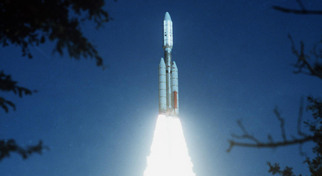
The launch date was chosen to take advantage of a particular planetary alignment that occurs only once every 176 years. This opportunity to visit the four major planets – Jupiter, Saturn, Uranus and Neptune – in one 12 year mission was originally identified by a JPL spacecraft engineer Gary Flandro. Prior to this, a mathematics graduate Micheal Minovitch had studied the dynamics of gravity assists (see page 71 of How Spacecraft Fly), and the two threads came together as proposal to fly the Voyager missions. Using more conventional methods, such a mission would have taken anything up to 30 years to reach distant Neptune. But with each successive swing-by, the spacecraft received a boost in Sun-relative speed to enable a complete tour of the four major planets within a period of time which allowed a reasonable probability that the spacecraft would still be functional at destination. A chart of the speed profile for Voyager 2 can be found on page 75 of How Spacecraft Fly.
The mass of the Voyager spacecraft was around 700 kg, with a ‘beginning of life’ power of 420 W from 3 RTGs (radioisotope thermal generators). Voyager 2 (V2) was actually launched first on 20 August 1977, followed days later by the launch of Voyager 1 (V1) on 5 September. However V1 reached Jupiter and Saturn before V2. The V2 spacecraft then went on to visit Uranus and Neptune as well, the only spacecraft to date ever to do so.
Currently, after their 35 year mission, V1 is around 18 billion km (18,000,000,000) from the Sun in a position North of the Earth’s orbit plane, and V2 is 15 billion km distant, South of the plane. This is around 120 AU and 100 AU respectively. There is currently some excitement about the proximity of V1, in particular, to the heliopause. This is the boundary between the physical sphere of influence of the Sun and interstellar space. Onboard instruments are recording an increase in high-energy particles from outside the sphere of influence, while simultaneously registering a dip in low-energy particles emanating from the Sun. It is anticipated that V1 could become the first man-made object to enter interstellar space in the next 5 years or so. The engineers at JPL anticipate that the spacecraft has sufficient electrical power to continue operations until about 2020.
Voyager has been an amazingly successful programme in terms of the huge volume of scientific data collected during the ‘grand tour’of the major planets. Along the way the 2 spacecraft have given us many beautiful images of these stage worlds, and made discoveries beyond our imagination. In terms of the major astronautical achievements of the 20th Century, I would rate Voyager in the top three, along with Sputnik 1, and Apollo. Voyager is now, however, a 21st Century phenomenon as well!


 RSS Feed
RSS Feed
